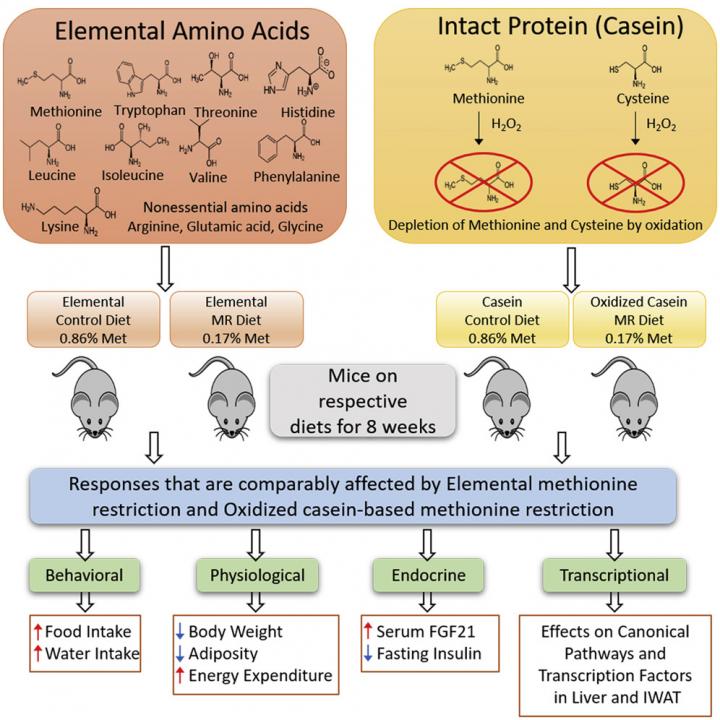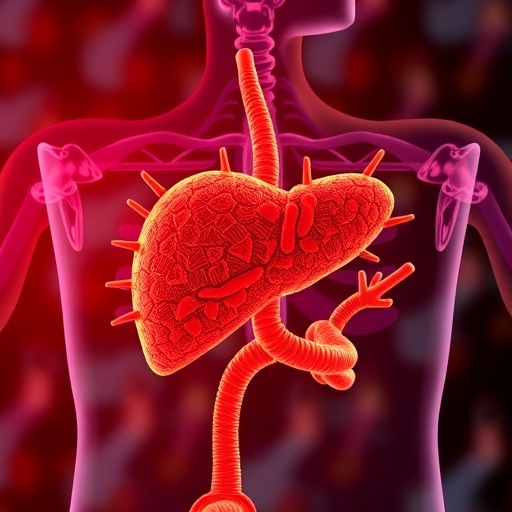
Credit: Pennington Biomedical Research Center
BATON ROUGE, Louisiana – A diet that improves the biomarkers of metabolic health, and that could potentially slow the aging process, has moved a step closer to reality.
“We’ve known for years that restricting the amino acid methionine in the diet produces immediate and lasting improvements in nearly every biomarker of metabolic health,” said Thomas W. Gettys, PhD, Professor and Director, Nutrient Sensing and Adipocyte Signaling Laboratory at Pennington Biomedical Research Center. “The problem is that methionine-restricted diets have been difficult to implement because they taste so bad.”
Until now. Restricting methionine normally involves diets formulated with elemental (e.g., individual) amino acids. Individual amino acids are the building blocks of proteins. But diets made from elemental amino acids taste bad, and few are willing to tolerate the regimen.
A palatable solution emerged from a collaboration between Dr. Gettys’ lab and food scientists at LSU who developed the methods to selectively delete methionine from casein, the main protein in milk and cheese. Dr. Gettys’ lab then conducted the proof-of-concept testing to establish that oxidized casein could be used to implement methionine restriction without the objectionable taste of the standard elemental diet.
More than two-thirds of Americans are overweight or have obesity. More than 40 percent of adults have prediabetes or type 2 diabetes.
“A diet that offsets all the major components of metabolic disease would have an enormous impact on the nation’s health, and the world’s,” said Han Fang, PhD, a Postdoctoral Researcher in Dr. Gettys’ lab, and the lead author of the study.
A palatable, methionine-restricted diet could also ease a major frustration for those struggling to manage their weight. Each year, millions of people improve their metabolism and lose weight by reducing how much they eat. But eventually, most people gain back those pounds.
“Calorie restriction is an effective weight-management tool. But for most people it is also very, very difficult to follow long-term,” said Pennington Biomedical Executive Director John Kirwan, PhD. “This struggle is one of the major reasons our scientists explore every avenue to find solutions to the obesity epidemic.”
Although the oxidized casein diet represents a major advance, Gettys and his team say more research is needed. Their study, published in the journal iScience, involved mice. Translating the results to produce a methionine-restricted human diet, which is far more complex and involves multiple sources of protein, will be challenging.
In the short term, a practical solution may be to develop a palatable group of modified proteins to serve as the basis of a therapeutic diet. People would follow the diet for a limited period while under medical supervision.
###
This work was supported by the National Institute of Diabetes and Digestive and Kidney Diseases of the National Institutes of Health under Award number R01 DK096311. The content is solely the responsibility of the authors and does not necessarily represent the official views of the National Institutes of Health.
About the Pennington Biomedical Research Center
The Pennington Biomedical Research Center is at the forefront of medical discovery as it relates to understanding the triggers of obesity, diabetes, cardiovascular disease, cancer and dementia. The Center conducts basic, clinical, and population research, and is affiliated with Louisiana State University. The research enterprise at Pennington Biomedical includes over 450 employees within a network of 40 clinics and research laboratories, and 13 highly specialized core service facilities. Its scientists and physician/scientists are supported by research trainees, lab technicians, nurses, dietitians, and other support personnel. Pennington Biomedical is located in state-of-the-art research facilities on a 222-acre campus in Baton Rouge, Louisiana. For more information, see http://www.
Pennington Biomedical Research Center
6400 Perkins Road
Baton Rouge, LA 70808
Media Contact
Ted Griggs
[email protected]
Related Journal Article
http://dx.




